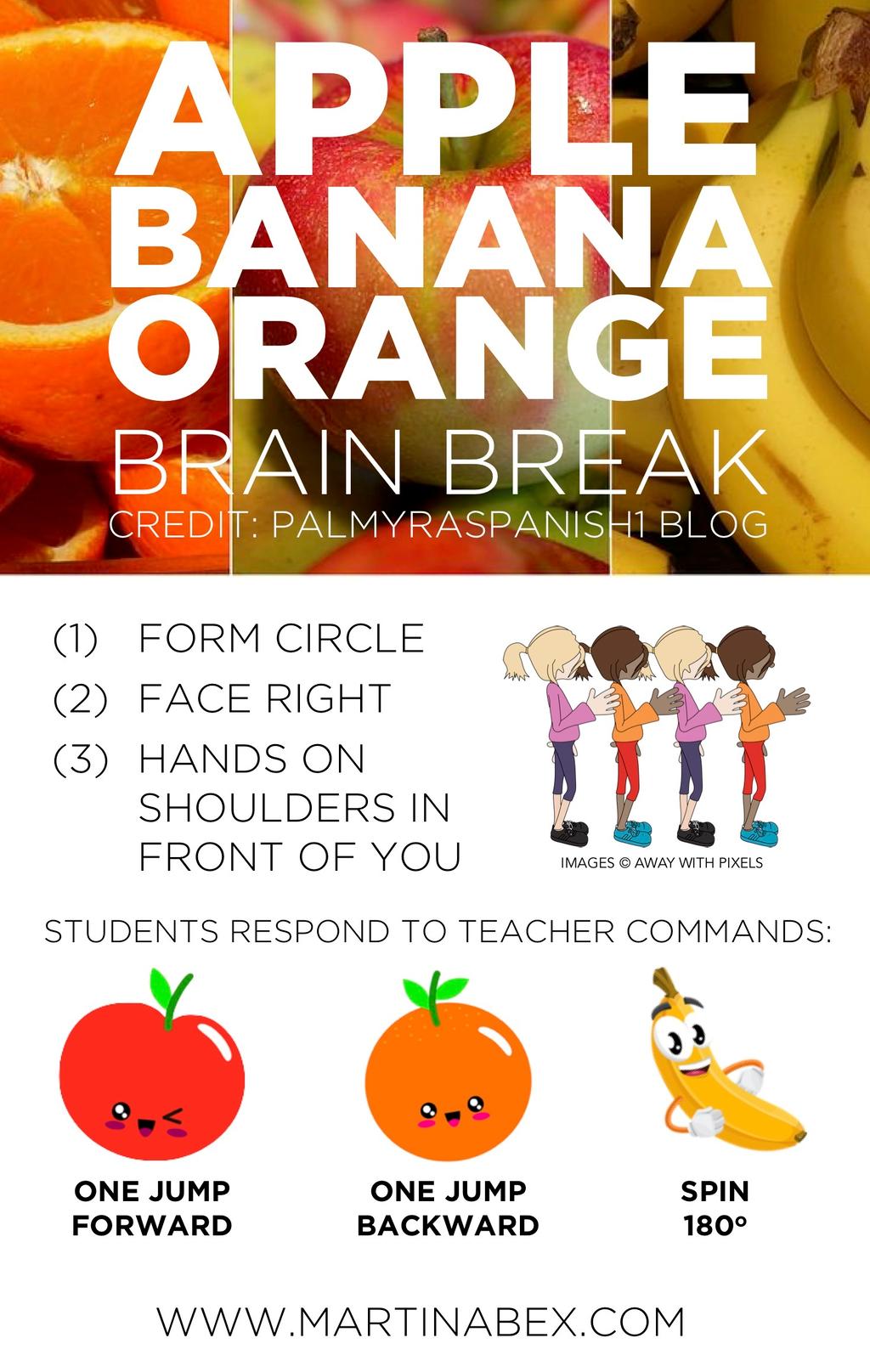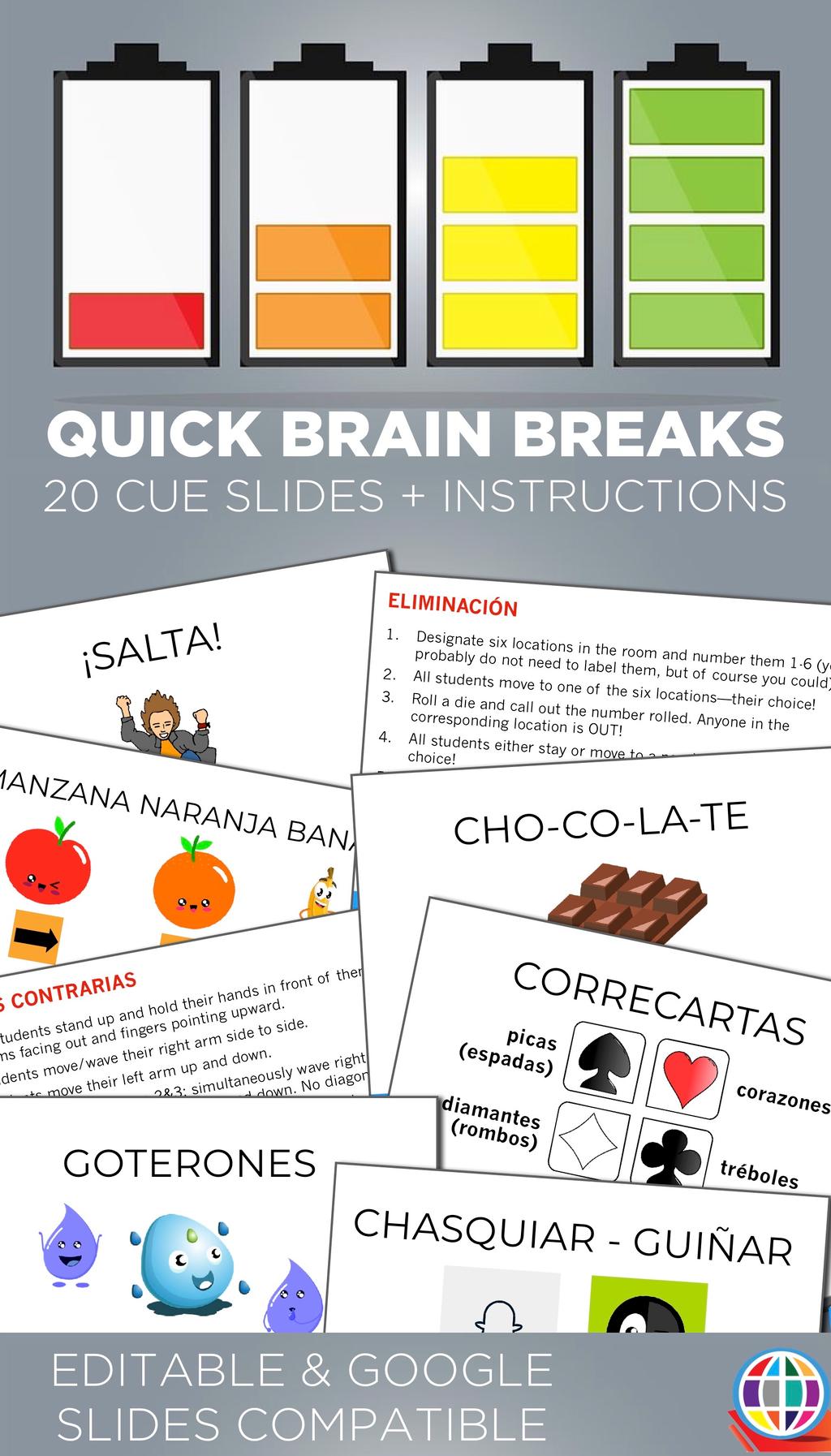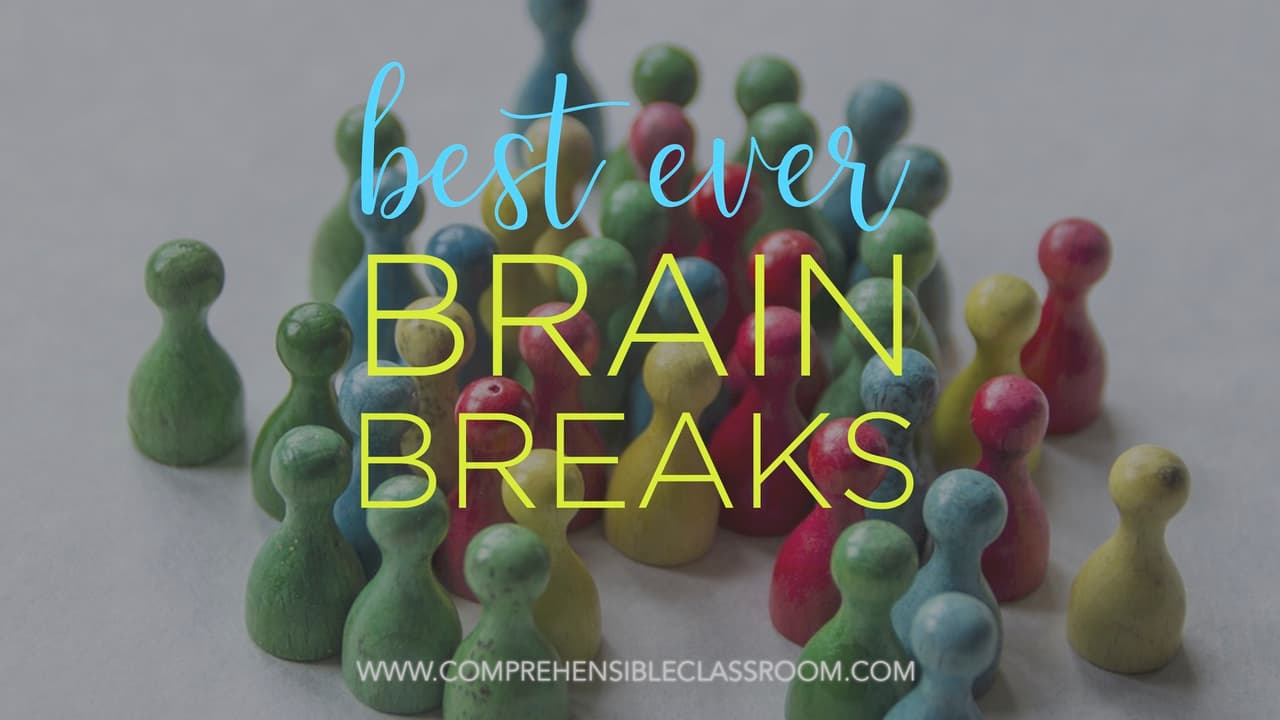Reading and listening are the core components of comprehension based language classes. We know that students acquire language when they hear and read messages that they understand--so read and listen they will! Sometimes, we share short, easily digestible texts with students. Other times, we need to read a text of a significant length in order to have a meaningful conversation. It is during those class sessions especially when brain breaks are critical. WHAT IS A BRAIN BREAK? The Watson Institute defines brain breaks on their website:
Brain breaks are mental breaks designed to help students stay focused and attend. The brain breaks get students moving to carry blood and oxygen to the brain. The breaks energize or relax. The breaks provide processing time for students to solidify their learning (Jensen) (adapted from Alison Newman).
What I appreciate about this definition is that it shows the diverse nature of brain breaks. They might help 'wake students up' after a lull, or they might 'bring students down' after a wild or a stressful activity. I am confident that you have experienced the power of a brain break sometime in your professional career; even if it's a five-minute bathroom break offered during a workshop! Returning to a learning session after a break, we feel more alert and ready to tackle the next challenge. WHAT MAKES A GOOD BRAIN BREAK? In a dream world, a brain break requires students to cross their midline (the invisible line drawn from the top of their head straight down through the center of their body). I have written about this before, after first hearing it from Michele Whaley! Crossing the midline--meaning a left body part crosses in front or behind the left side of the body--encourages communication between the brain's left and right hemispheres. We want BOTH sides of their brains to be firing so that their full mind can participate in the learning. 
BEST BRAIN BREAKS
Here are a few of my favorites--some new, and some old!
HOUSE ROCK TREE
- Students move around the room, ideally to music.
- Teacher [pauses music and] shouts out, “HOUSE ROCK TREE” (in the target language--in my case, this would be "CASA PIEDRA ÁRBOL").
- Students QUICKLY form groups of three and as fast as possible each one takes on a unique role: (1) HOUSE: Stand with arms over head in triangular shape so that it looks like a roof (2) ROCK: Squat, tuck head, and put arms over head as if protecting it from falling debris; to look as rock-like as possible! (3) TREE: Stand with arms raised in the “Y” shape (like from YMCA) to form branches stretching upward and outward to the sky!
- [Restart music and] students move around again.
- Repeat Steps 2-4 for 1-2 minutes!
 HIGH FIVE - POUND IT
HIGH FIVE - POUND IT
- Students pair up and stand facing each other.
- Partners make a fist with left hands and hold up right hands, palm facing out.
- Partners high five each other with right hands.
- Partners fist bump left fists.
- Partners make a fist with right hands and hold up left hands, palm facing out.
- Partners high five each other with left hands.
- Partners fist bump right fists.
- Repeat for one minute.
TEN I originally learned this game from Charlotte Meyer, who shared it on the FLTeach Listserv.
- Students stand in a circle.
- In order, clockwise around the circle, students count aloud the numbers 1-10. Each student can say one, two, or three numbers when it is their turn (they could say dos, or dos-tres, or dos-tres-cuatro).
- Whoever says the number 10 is OUT and must sit down.
- Play until one student remains!
Once your students have down the numbers 1-10, it seems that it would be wise to change how you count: either 11-20, 21-30, 10-100 by 10’s, 5-50 by 5’s, 100-1000 by 100’s, etc.
 ROCK PAPER SCISSORS TRAIN
ROCK PAPER SCISSORS TRAIN
- Students pair up and play three rounds of Rock Paper Scissors. Best of three wins!
- Loser gets behind winner and puts hands on winner’s shoulders, forming a “train”.
- Winner (front of train) now finds another train and plays three rounds of Rock Paper Scissors. Best of three wins!
- Entire losing train joins the end of the winning train.
- Repeat Steps 3-4 until there there is one winner!
I learned this “Train” version from Annabelle Allen, who learned it from The Great Darcy Rogers of Organic World Language.
Unfamiliar with basic “Rock Paper Scissors”? Watch this video:
APPLE BANANA ORANGE This is the newest brain break that I have added to my repertoire, and I read about it on Cynthia Hitz' blog after it was taught to her by Krista Kovalchick.
- Students form a circle, turn to the right, and place hands on the shoulders of the person in front of them.
- Teacher calls out a command (*in the target language!) and the class responds accordingly:
- APPLE: One jump forward
- ORANGE: One jump backward
- BANANA: Flip 180 degrees, so that you are now facing the opposite direction (and your hands are on a different classmates’ shoulders)
- Play for 2-3 minutes.
 PASS THE CLAP
PASS THE CLAP
- Students form several small circles (5-10 students per circle) or one large circle.
- All students fold hands as if playing and hold them toward the right side of their body.
- Designated student starts by moving their hands from the right side of the body to their left, making eye contact with the person immediately to their left, and clapping.
- When eye contact is made and clap is heard, the next student moves hands from right to left across their body, makes eye contact with the next student in line, and claps.
- Repeat, “passing” the clap around the circle, for 1-3 minutes. Time how fast you can get around the circle! Remember: The clap can only be “passed” via direct eye contact with the receiver!
KARATE HANDS I love this brain break, but you do need to be careful to coach students to use gentle tags, not their full-on martial arts skills--real or imagined.
- Play music while students move around the room.
- STOP music; students PAIR up and FREEZE in karate poses.
- Teacher says “NOW!”
- Each partner moves one hand (ONLY one hand!) to attempt to either gently tag one of their partner’s hand or to evade being tagged by their partner—MOVE ONE HAND ONLY (evade or attack). Four scenarios:
- “John” hits a hand that “Bob” didn’t move = point for John
- “Bob” hits a hand that “John” didn’t move = point for Bob
- “John” or “Bob” moves away a hand that the other partner tried to hit = no points
- “John” and “Bob” hit each others’ moving hands = no points
- Repeat for a total of five attempts (NOW! / NOW! / NOW! / NOW! / NOW!).
- Turn on music again; students move around the room.
- Repeat Steps 2-6 for 1-2 minutes.
 HOW CAN I REMEMBER TO USE BRAIN BREAKS? One strategy that has worked well for me (and that I use when I am giving workshops!) is to strategically place slides into my slideshow presentations that correspond to a brain break. If I am doing a multi-slide reading, I plop a brain break slide in the middle of them. This could be as simple as a slide labeled "BRAIN BREAK", or it could designate which specific brain break to do at that moment (this works better for me so that I don't have to think on the fly--in which case I always end up using the same brain break!). Click here to get Spanish cue slides to help you make brain breaks a regular part of your classes! I have compiled 20 of my favorite brain breaks in this slideshow. For each brain break, there is a cue slide (in Spanish) and a separate instructions slide (for the teacher to reference). Cue slides can be copied and pasted into any slideshow that you use in class--PDF, PPT, and Google Slides versions are included! Looking for English cue slides? No problem!
HOW CAN I REMEMBER TO USE BRAIN BREAKS? One strategy that has worked well for me (and that I use when I am giving workshops!) is to strategically place slides into my slideshow presentations that correspond to a brain break. If I am doing a multi-slide reading, I plop a brain break slide in the middle of them. This could be as simple as a slide labeled "BRAIN BREAK", or it could designate which specific brain break to do at that moment (this works better for me so that I don't have to think on the fly--in which case I always end up using the same brain break!). Click here to get Spanish cue slides to help you make brain breaks a regular part of your classes! I have compiled 20 of my favorite brain breaks in this slideshow. For each brain break, there is a cue slide (in Spanish) and a separate instructions slide (for the teacher to reference). Cue slides can be copied and pasted into any slideshow that you use in class--PDF, PPT, and Google Slides versions are included! Looking for English cue slides? No problem!  Now--go give yourself a brain break!
Now--go give yourself a brain break! 



